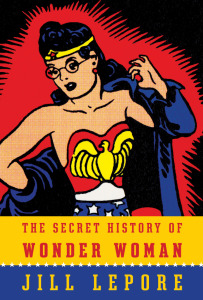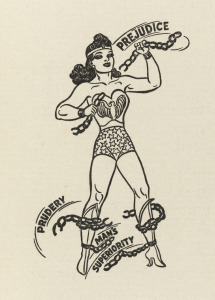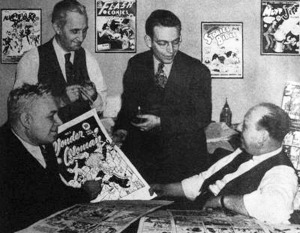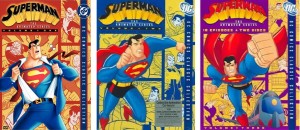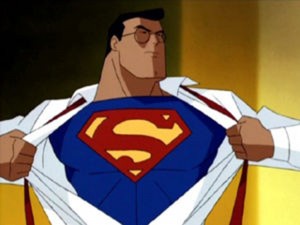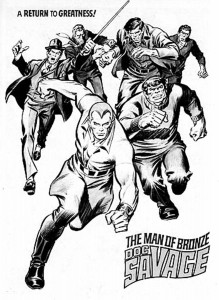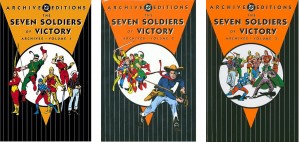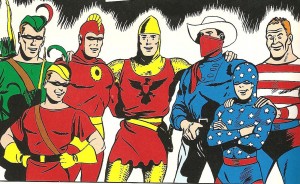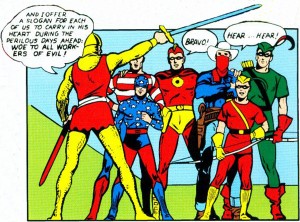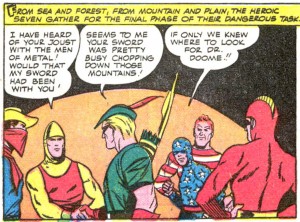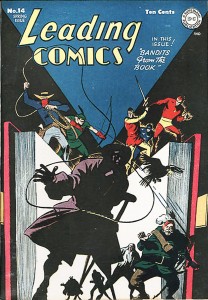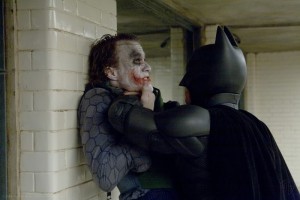(JACK KIRBY and others; 1535 pages; DC COMICS, 2017) A REVIEW FROM THE VAULT

Okay… I know that I’m approaching the precipice of sacrilege here but, I’ve never been a big fan of Jack Kirby’s style. I’m not disparaging what the man meant (and still means) in the creative realm of comic books; I mean, this is the guy that co-created Captain America and much of the Marvel Universe as we know it. Don’t get me wrong, I read all of those books and, believe it or not, the very first comic I bought – 1963… I was four or five years old – was purchased because of a Kirby cover image (a five year old issue of DC’s SHOWCASE starring CHALLENGERS OF THE UNKNOWN showing the heroes being menaced by a giant kraken). But, the artists that kept me interested in comics offered a more realistic vision (or, at least, as realistic as one can get depicting muscular men and women in brightly colored spandex beating the crap out of each other for twenty or so pages): Neal Adams and Gil Kane were always my favorites and, eventually, I came to appreciate the work of guys like John Buscema, Gene Colan, Jim Aparo and so many others. When Jack bolted from Marvel for DC Comics and more creative freedom in the early 1970s, I wasn’t into much of what DC was doing (other than the stuff that Kane and Adams were drawing) and had very little interest in Jack Kirby’s wildly confusing titles. A couple of years later, I started to get into what DC was doing and I even gave Kirby another look. MISTER MIRACLE (which was actually part of the Fourth World saga) was pretty cool and, by the time KAMANDI, THE LAST BOY ON EARTH and THE DEMON came along, I may not have been hooked but, I was reading them… actually READING them, rather than just looking at the “purdy pitchers.”

Part of Kirby’s deal with DC was that he got to choose and ongoing title. So, of course, he chose one of the biggies, right? Nope. He picked a title that was selling just enough copies to keep it form being canceled: SUPERMAN’S PAL, JIMMY OLSEN. He slowly started introducing the concept that would become known as the Fourth World in that title. He eventually expanded the idea to include three titles which he created, FOREVER PEOPLE, NEW GODS and the previously mentioned MISTER MIRACLE. My take on these titles at the time (based almost entirely on the covers in the spinner rack) was that an old dude was attempting (and failing) to be hip and cool with stories about hippies and communes and peace and love. What I did actually read of those titles kinda confirmed that assumption. So, then, why am I bothering to write about something that I summarily dismissed nearly fifty years ago? Well, for starters, what is probably the King’s greatest creation from that period in his career has gone on to be considered one of the ultimate villains in the entire DC Universe and was featured in one of the best story arcs in SUPERMAN: THE ANIMATED SERIES; taking the concepts of the Fourth World and the consummate evil that is Darkseid, expanding and including them in a lot of the major series at DC (Superman, Justice League and others) prompted me to take another look at the original work. Plus… I got a really awesome deal on this monster of a collection!

Beginning with SUPERMAN’S PAL, JIMMY OLSEN number 133, Kirby took control of the wheel, careening wildly across several genres, leaving behind – for the most part – the sophomoric gimmicks that most of the Superman titles (and, let’s be honest, a lot of DC’s super-hero books) had been subjected to for nearly twenty years. There was a problem with Jack’s work, though: His Superman didn’t look like Superman (in retrospect, I gotta say that his version of the Last Son of Krypton looked a whole lot like one of his Marvel creations, Wyatt Wingfoot). So, DC sicced their versions of Marvel’s John Romita (who was charged with giving the characters there a uniform look, no matter who the artist was), Al Plastino and Murphy Anderson, on Kirby’s Supes. The pair were charged with redrawing every image of Superman (and Clark Kent… even the book’s titular character) over every one of his appearances in a Jack Kirby book! There are examples of Kirby’s original pencils in a special section in the back of this tome and, yeah, they don’t look like the Superman that readers had become accustomed to for decades but (and I can’t believe I’m writing this), they weren’t as horrible as the powers-that-be at DC made them out to be… just different. Sometimes, the King’s swerves side-swiped a few other characters, as well. For instance, Boston Brand (Deadman) showed up in an issue or two of NEW GODS and looked nothing like the Neal Adams version that we’d all come to know and love; comedian Don Rickles guest-starred in a couple of issues of SUPERMAN’S PAL, JIMMY OLSEN. At times, it seemed that Kirby sorta got lost in his own storylines, taking a road less (or never) traveled and forcing his characters and his readers to adjust on the fly. It definitely made for a rather confusing, often bumpy, never boring ride.

These stories were very much a product of their time and should be consumed as such. Like I mentioned earlier, they seemed very much like ol’ Jack was trying way too hard to be hip and relevant for the youngsters who read comic books in the early ‘70s. As with most of his work throughout his career, the Fourth World saga explored the eternal struggle of good versus evil, both externally (the New Gods of New Genesis versus Darkseid and his Apokolips minions) and internally (the conflicted natures of the main hero, Orion). There are definitely similarities between the early stories of Joe Simon and Jack’s star-spangled hero, Captain America, and his war against Adolph Hitler, with Darkseid the sadistic madman and dictator and Orion as the noble hero seeking to stamp out injustice and intolerance wherever it reared its ugly head. The artwork was the usual over-the-top variety of cartoony stuff that Kirby excelled at, with blunted fingers and large, wide-opened mouths and his take on “Mod” clothing styles. The plots, likewise, were over-the-top and infinitely more confusing than they needed to be while the writing was… well, the King coulda used some help with the dialogue. He really needed someone like Bob Haney or Gardner Fox to rein in some of the hipster slang and overwrought verbiage that his characters were spewing on a regular basis. Giving the man editorial reign over his own work may not have been the best idea to ever come out of the executive offices at 909 Third Avenue in New York. Even with those complaints – more like observations, actually – looking at the whole thing collected in one 1500 page book is impressive! One of Jack’s long-time Marvel inkers, Vince Coletta, began the wild ride with him. I always liked Coletta’s work, thin-lined and classy; most fans couldn’t stand him… especially over Jack Kirby. I sort of understand that because Kirby’s style is very strong, with thick lines and not a lot of intricacy. Somewhere along the line, Vince gave way to Mike Royer, who became the go-to inker on most of the King’s work from 1971 forward; according to Kirby’s production assistant, Mark Evanier, he (Evanier) was instrumental in the artist’s decision to move on from Coletta. It’s fairly apparent that Royer was a big fan and knew how to bring out the best in Kirby’s work, with thick lines and large patches of black.

Okay… the question, then, is why did I ultimately choose to pick up this admittedly hefty tome (aside from the bargain price) and delve into something that I couldn’t get into in my youth? Obviously, Darkseid had a lot to do with it and, as I said, I was kinda digging MISTER MIRACLE as that title seemed to be (mostly) outside of the major Fourth World continuity. Of course, most of the characters eventually became integrated into the main DC Universe, even making appearances in those classic DC animated series of the ‘90s and aughts (BATMAN, SUPERMAN, JUSTICE LEAGUE and JUSTICE LEAGUE UNLIMITED). The animated versions are what really hooked me and nudged me to take another look at Kirby’s wild world. As influential as these titles have become, they really weren’t around too long: NEW GODS, which Jack envisioned as a limited series (a virtually unheard of concept in the early 1970s), lasted several issues longer than he had intended because the DC higher-ups wanted to ride the success train as long as possible, forcing Jack to bring in characters like Deadman to pad the story. With Kirby (and the readers) losing interest, the title was gone after eleven decidedly uneven issues. FOREVER PEOPLE, likewise, was gone after number 11; MISTER MIRACLE, a more traditional super-hero adventure book, hung around until issue 18. So, I guess the reason I decided to reevaluate my position on these titles may just be the fact that I had the whole saga piled together in one place. Don’t get me wrong, it is still a confusing mass (mess?) of cosmic proportions but, in the pantheon of regrettable comic book series, it hardly makes a blip. These books are more a product of a man with epic, sweeping ideas left pretty much to his own devices and, even after all this time, they simply cannot be ignored.

